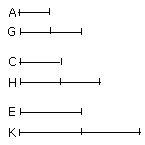If any number of magnitudes be proportional, as one of the antecedents is to one of the consequents, so will all the antecedents be to all the consequents.
 Let any number of magnitudes A, B, C, D, E, F be proportional, so that, as A
is to B, so is C to D and E to F;
Let any number of magnitudes A, B, C, D, E, F be proportional, so that, as A
is to B, so is C to D and E to F;
 I say that, as A is to B, so are A, C, E to B, D, F.
I say that, as A is to B, so are A, C, E to B, D, F.
 For of A, C, E let equimultiples G, H, K be taken,
For of A, C, E let equimultiples G, H, K be taken,
 and of B, D, F other, chance, equimultiples L, M, N.
and of B, D, F other, chance, equimultiples L, M, N.
 Then since, as A is to B, so is C to D, and E to F, and of A, C, E
equimultiples G, H, K have been taken, and of B, D, F other, chance,
equimultiples L, M, N,
Then since, as A is to B, so is C to D, and E to F, and of A, C, E
equimultiples G, H, K have been taken, and of B, D, F other, chance,
equimultiples L, M, N,
 therefore, if G is in excess of L,
therefore, if G is in excess of L,
 H is also in excess of M,
H is also in excess of M,
 and K of N, if equal, equal, and if less, less;
and K of N, if equal, equal, and if less, less;
 so that, in addition, if G is in excess of L, then G, H, K are in excess of L,
M, N, if equal, equal, and if less, less.
so that, in addition, if G is in excess of L, then G, H, K are in excess of L,
M, N, if equal, equal, and if less, less.
 Now G and G, H, K are equimultiples of A and A, C, E, since, if any number of
magnitudes whatever are respectively equimultiples of any magnitudes equal in
multitude, whatever multiple one of the magnitudes is of one, that multiple
also will all be of all.
Now G and G, H, K are equimultiples of A and A, C, E, since, if any number of
magnitudes whatever are respectively equimultiples of any magnitudes equal in
multitude, whatever multiple one of the magnitudes is of one, that multiple
also will all be of all.
 For the same reason L and L, M, N are also equimultiples of B and B, D, F;
For the same reason L and L, M, N are also equimultiples of B and B, D, F;
 therefore, as A is to B, so are A, C, E to B, D, F. [V. Def. 5]
therefore, as A is to B, so are A, C, E to B, D, F. [V. Def. 5]
Therefore etc.
Q.E.D